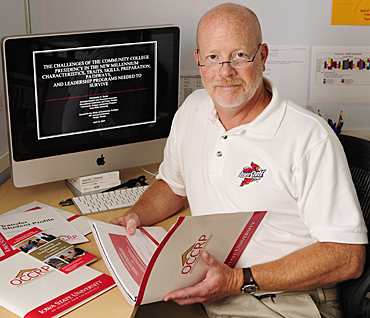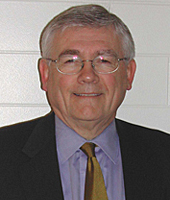Iowa State study of community college presidents finds national shortage on horizon
07-31-08
Click on picture below for print quality version.

Chris Duree led the national study of community college presidents and reported for his doctoral dissertation in Iowa State's Community College Leadership Program. Photo by Bob Elbert
Contacts:
Chris Duree, Community College Leadership Program, (515) 294-4143, cduree@iastate.edu
Larry Ebbers, Community College Leadership Program, (515) 294-8067, lebbers@iastate.edu
Frankie Santos-Laanan, Community College Leadership Program, (515) 294-7292, laanan@iastate.edu
Cathy Curtis, College of Human Sciences, (515) 294-8175, ccurtis@iastate.edu
Mike Ferlazzo, News Service, (515) 294-8986, ferlazzo@iastate.edu
Iowa State study of community college presidents finds national shortage on horizon
AMES, Iowa -- There appears to be a community college leadership shortage looming. A new Iowa State University study of 415 community college presidents -- representing 38.2 percent of the national total -- found that 79 percent will retire by 2012, and 84 percent by 2016.
The study also documents a shortage of qualified replacements, reporting that the number of degrees awarded to graduates of community college leadership programs decreased by 78 percent between 1983 and 1997.
"If you think about that time period, those would be the people who would really be in the chute to take the place of those who were retiring," said Chris Duree, who led the research and reported its results for his doctoral dissertation in Iowa State's Community College Leadership Program (CCLP).
"So actually, not only is there the anticipated exodus going out the door, but there also is a shortage of qualified candidates coming in," he said.
Duree -- who will be a lecturer and faculty clinician in CCLP starting this fall -- presented the results of the study, "The challenges of the community college presidency in the new millennium: pathways, preparation, competencies, and leadership programs needed to survive," in April at the Council for the Study of Community Colleges annual meeting in Philadelphia.
The data was collected in 2007 by a group of ISU researchers in the Department of Educational Leadership and Policy Studies (ELPS) and Office of Community College Research and Policy at Iowa State. The principal investigators were ELPS doctoral students working under the direction of University Professor of Higher Education Larry Ebbers and Associate Professor Frankie Santos-Laanan.
Study supported by national association
The American Association of Community Colleges (AACC) provided a national list of community college presidents to the researchers. The ISU Center for Survey Statistics and Methodology staff mailed letters to 1,112 community college presidents serving in the 2006-2007 academic year to notify them of the study and invite them to participate in the online questionnaire. Presidents were given a little over a month last summer to complete the questionnaire and 391 were completed entirely, with 24 partially completed surveys also included in the final data set.
The looming leadership shortage translates into great financial opportunity for those who are currently candidates for community colleges presidential openings, but limited pools for those who are running the searches.
"We know from my searches and other searches around the country that there are fewer candidates than there were," said Ebbers, who consults with various community colleges on their presidential searches. "Most pools now are 25 to 30 candidates -- except in larger, more attractive areas like Florida and Texas and the South in general.
"It's improving salaries for candidates," he said. "I just did one search where the candidate we ultimately decided on was in four searches and had four offers. So the competition for candidates is what I would call keen."
One of Duree's co-major professors, Ebbers reports that 52 of the 109 community colleges in California had presidential vacancies this past academic year.
Presidents and vice presidents nearly the same age
The study found the average age of community college presidents is 58, while the average age of vice presidents -- those most likely to become presidents -- is 57. Only one-third of community college presidents are women.
In addition to the leadership shortage, the study also found:
- The top five challenges facing current community college leaders are: fund raising, student enrollment and retention, legislative advocacy, economic and workforce development, and faculty relations.
- Overall, current community college presidents rated themselves prepared or well-prepared in the "Competencies for Community College Leaders" identified by AACC.
- Current community college leaders were less likely to be prepared in the skill sets needed for organizational strategy and resource management domains.
- Formal leadership programs and educational preparation in the highest degree earned play significant role in how presidents perceived their level of preparation prior to assuming their first chief executive officer position.
Duree says that the two most pressing concerns of community college presidents are fund raising and legislative advocacy.
"These results suggest that presidents are under considerable pressure to seek alternative funding strategies that can offset the rising costs of offering quality educational programs without passing the expense to students," he said.
Duree -- who previously spent nine years as the vice president of instruction, chief academic officer and career and technical education dean at Southwestern Community College in Creston, Iowa -- hopes to publish multiple papers in professional journals out of his dissertation research.
-30-

